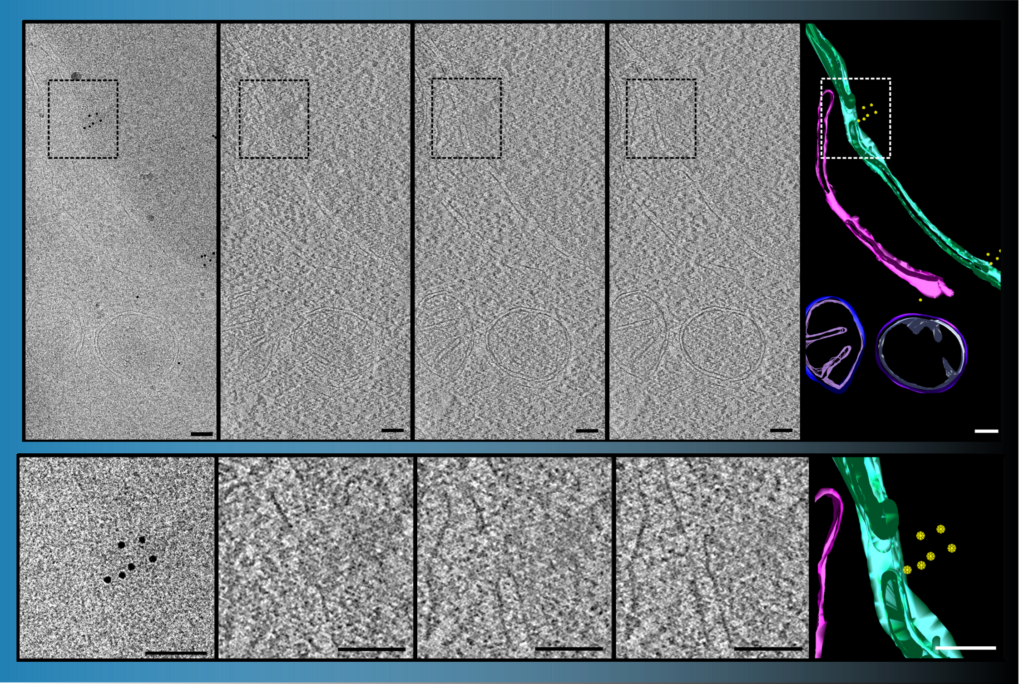Présentation

Resin embedding
The embedding of a soft biological sample in a plastic resin hardens it enough for thin sectioning. In this way the sample is ready for TEM, TEM-tomography, and FIB-SEM tomography. Classical preparation consists of fixation with aldehydes, fixation of lipids with osmiumtetroxide, dehydration, and embedding in resin before sectioning with a microtome.
We have three microtomes dedicated for RT sectioning of plastic resins in our lab.
Guerbois M, Moris A, Combredet C, Najburg V, Ruffié C, Février M, Cayet N, Brandler S, Schwartz O, Tangy F. (2009) Live attenuated measles vaccine expressing HIV-1 Gag virus like particles covered with gp160DeltaV1V2 is strongly immunogenic. Virology. 388:191-203
High pressure freezing
High pressure freezing (HPF) arrests the biological activity of the sample within miliseconds. The sample is frozen without formation of ice crystals (vitrification). It can be either processed by freezesubstitution for resin embedding, or for cryo-sectioning and cryo-TEM (CEMOVIS), or for cryo-FIB-SEM.
We have a Leica EM Ice high pressure freezer ready to use.
Zhang G, Sachse M, Prevost MC, Luallen RJ, Troemel ER, Félix MA. (2016) A Large Collection of Novel Nematode-Infecting Microsporidia and Their Diverse Interactions with Caenorhabditis elegans and Other Related Nematodes. PLoS Pathog. 12:e1006093
Tokuyasu cryosectioning
This approach allows a good preservation of antigens for immunolabeling. After a mild fixation with aldehydes and cryoprotection, the sample is hardened without plastic embedding by freezing. Thin sections are prepared in the frozen state and labeled at RT after thawing.
We have three cryo-microtomes available for this approach.
Paz I, Sachse M, Dupont N, Mounier J, Cederfur C, Enninga J, Leffler H, Poirier F, Prevost MC, Lafont F, Sansonetti P. (2010) Galectin-3, a marker for vacuole lysis by invasive pathogens. Cell Microbiol. 12:530-44
Plunge freezing
For samples with thickness < few microns, such as isolated particles including proteins, macromolecular complexes, decorated liposomes, viruses, bacteria, eukaryotic cells….
Samples are deposited or grown directly onto EM grids and cryo-fixed in their hydrated state by plunge freezing in liquid ethane at liquid nitrogen temperature. As a result, the sample is vitreous (non-crystalline) and embedded in a thin layer of vitreous ice, that ensures the highest structural preservation of the sample.
For imaging in a cryo-TEM, the ice thickness should not exceed ~500 nm.
For thicker samples (> 1 um), three options are available:
- plunge-freezing followed by cryo-FIB-SEM thinning with cryo-lamellae
- HPF followed by cryo-sectioning (CEMOVIS)
- Vitrification by plunge-freezing of Tokuyasu-style Sections (VoS)
Note: Plunge-freezing is compatible with chemical fixation of the sample.
Remodeling of the core leads HIV-1 pre-integration complex in the nucleus of human lymphocytes, J. Virol. 2020 Apr;.











